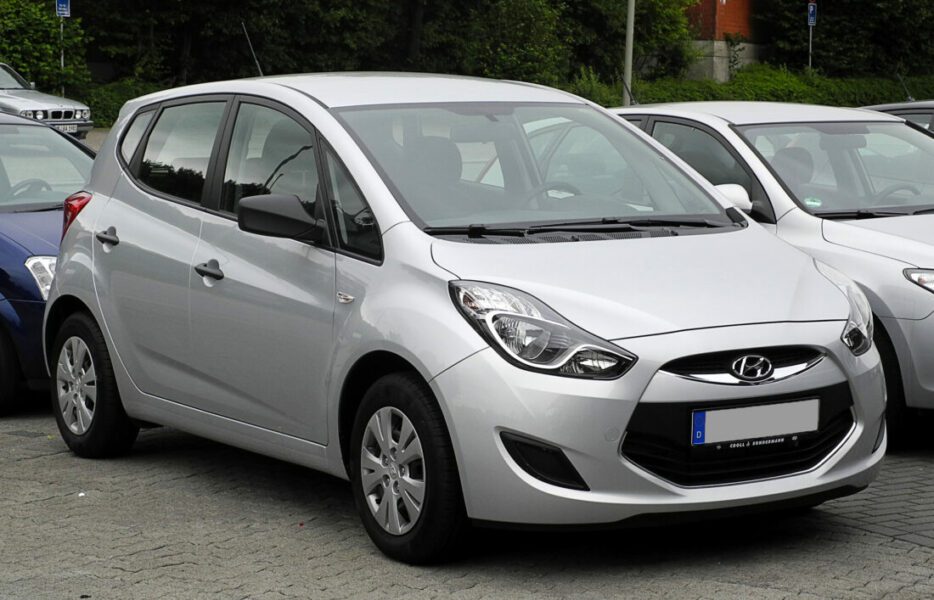
Test: Hyundai ix20 1.4 CVVT (66 kW) Comfort
Content
Hyundai and Kia have fundamentally different principles. Hyundai, as the majority owner of this Korean house, is characterized by calm elegance, while Kia is a little more sporty. It's safe to say that Hyundai is for a little older, and Kia is for younger ones. But with the ix20 project and Venga, they have clearly switched roles, as Hyundai looks much more dynamic. Deliberately?
Part of that dynamism can be attributed to the more pronounced headlights, and part to the variegated honeycomb mask and fog lamps pushed back along the edge of the bumper. The turn signals, unlike the Vengo, are mounted in the rear-view mirrors, as the Kia sister has the classic side yellow bulges under the triangular side windows. Otherwise, the ix20 has never had sporting ambitions, the Hyundai Veloster is pursuing them. However, with a fresh image, they can still hope to rejuvenate customers, which is far from a bad thing, since these (usually) brands are loyal for a few more decades.
Of course, the Hyundai ix20 is virtually indistinguishable from the Kie Vengo we published in our 26th issue last year. Therefore, we advise you to read the article by Vinko's colleague first, and then continue this text, as we will focus more on the differences between the two Korean rivals. Should he write to the allies
The dynamism of the Czech ix20 is also felt in the interior. Where the Venga has three classic circular analog gauges, the ix20 has two (blue) and a digital display in between. Although the digital display does not seem to be the most transparent, we had no problems with monitoring the amount of fuel and the temperature of the coolant, and the data from the on-board computer was also clearly visible. All keys and levers on the center console are transparent and large enough to be problem-free even for the elderly. If you look at the steering wheel, you can count up to 13 different buttons and switches that are laid out so well that they don't go gray in use.
The driver's first impression is a pleasant working environment, as the driving position is good and visibility is excellent despite the single-seat architecture. The rear bench, fore and aft adjustable by a third, is a great addition to the already useful large boot space. In fact, there are two rooms in the chest, since one for small things is hidden in the basement. But what happens behind the wheel can be described in one word: softness. The power steering is more colorful, feels more comfortable to the touch, the gear lever moves from gear to gear like clockwork.
My better half was totally impressed by the softness, and my little one was a little more critical, as too much power steering means less understanding of what is happening to the front wheels and as a result it also means a lower rating. for active safety. The chassis is comfortable so it tilts in corners, although then the same chassis shakes with live content even as the snail gets over speed obstacles. First of all, we have to cover up the lack of soundproofing, as too many decibels penetrate the passenger compartment just below the chassis and engine compartment. Part of that weakness can be attributed to the five-speed transmission that raises the white flag at higher highway speeds, and above all, it is very annoying when it comes to fuel consumption.
The Hyundai ix20 is a really small minivan powered by a 1,4-litre petrol engine, so even common sense should know there can't be a lifesaver. But the average 9,5 liters is not his greatest pride, and Venga with Vinko at the wheel consumed an average of 12,3 liters. Are you saying you'll spend less? Maybe, but at the cost of some brave road users behind you in line...
You can't go wrong with Comfort equipment, everything you need is on the list. Four airbags, two side curtain airbags, automatic air conditioning, hands-free radio, cruise control and speed limiter, ABS and even a cool box in front of the passenger is more than a good traveler, the only drawback is that without a system You get ESP as standard only in the best Style package. So add 400 euros to the price of an ESP test car with start assist and the package is perfect! By our standards, Hyundai's five-year warranty is even better than Kia's seven-year warranty, since Kia has a mileage limit and a five-year shorter rust-proof warranty.
Hyundai or Kia, ix20 or Venga? Both are good, small differences will probably decide the proximity to the service and the terms of the warranty. Or the amount of the discount earned.
text: Alyosha Mrak, photo: Sasha Kapetanovich
Hyundai ix20 1.4 CVVT (66 kW) Comfort
Basic data
| Sales: | Hyundai Auto Trade Ltd. |
|---|---|
| Base model price: | 12.490 € |
| Test model cost: | 15.040 € |
| Power: | 66kW (90 KM) |
| Acceleration (0-100 km / h): | 13,4 with |
| Maximum speed: | 168 km / h |
| Mixed flow ECE: | 9,5l / 100km |
| Guarantee: | 5-year general and mobile warranty, 5-year varnish warranty, 12-year anti-rust warranty. |
| Systematic review | 30.000 km |
Cost (up to 100.000 km or five years)
| Regular services, works, materials: | 510 € |
|---|---|
| Fuel: | 12.151 € |
| Tires (1) | 442 € |
| Loss of value (within 5 years): | 4.152 € |
| Compulsory insurance: | 2.130 € |
| CASCO INSURANCE (+ B, K), AO, AO + | 2.425 ( |
| Calculate the cost of auto insurance | |
| Buy up | € 21.810 0,22 (km cost: XNUMX €) |
Technical information
| engine: | 4-cylinder - 4-stroke - in-line - petrol - mounted transversely at the front - bore and stroke 77 × 74,9 mm - displacement 1.396 cm³ - compression ratio 10,5:1 - maximum power 66 kW (90 hp) ) at 6.000 rpm - average piston speed at maximum power 15,0 m / s - specific power 47,3 kW / l (64,3 hp / l) - maximum torque 137 Nm at 4.000 rpm – 2 camshafts in the head (toothed belt) – 4 valves per cylinder |
|---|---|
| Energy transfer: | engine-driven front wheels - 5-speed manual transmission - gear ratio I. 3,769 2,045; II. 1,370 hours; III. 1,036 hours; IV. 0,839 hours; v. 4,267; – differential 6 – rims 15 J × 195 – tires 65/15 R 1,91, rolling circumference XNUMX m |
| Capacity: | top speed 168 km/h - acceleration 0-100 km/h 12,8 s - fuel consumption (ECE) 6,6 / 5,1 / 5,6 l / 100 km, CO2 emissions 130 g / km |
| Transportation and suspension: | limousine - 5 doors, 5 seats - self-supporting body - front single suspension, spring legs, three-spoke transverse guides, stabilizer - rear spatial axle with two transverse and one longitudinal guides, coil springs, telescopic shock absorbers, stabilizer - front brake disc (forced), rear disc, ABS, mechanical parking brake on the rear wheels (lever between seats) - rack and pinion steering wheel, electric power steering, 2,9 turns between extreme points |
| Mass: | empty vehicle 1.253 kg - permissible total weight 1.710 kg - permissible trailer weight with brake: 1.300 kg, without brake: 550 kg - permissible roof load: 70 kg |
| External dimensions: | vehicle width 1.765 mm - front track 1.541 mm - rear track 1.545 mm - ground clearance 10,4 m |
| Inner dimensions: | width front 1.490 mm, rear 1.480 mm - front seat length 500 mm, rear seat 480 mm - steering wheel diameter 370 mm - fuel tank 48 l |
| Standard equipment: | driver and front passenger airbags - side airbags - curtain airbags - ISOFIX mounts - ABS - power steering - automatic air conditioning - power windows front and rear - electrically adjustable and heated door mirrors - multifunction steering wheel - radio with CD player and MP3 player - remote central locking - steering wheel with height and depth adjustment - height adjustable driver's seat - separate rear seat - trip computer - cruise control. |
Our measurements
| T = -2 ° C / p = 999 mbar / rel. vl. = 55% / Tires: Dunlop SP Winter Sport 3D 195/65 / R 15 H / Mileage status: 2.606 km | |
| Acceleration 0-100km: | 13,4s |
|---|---|
| 402m from the city: | 18,9 years ( 118 km / h) |
| Flexibility 50-90km / h: | 14,4s (IV/V) |
| Flexibility 80-120km / h: | 21,3s (Sun./Fri.) |
| Maximum speed: | 168km / h (V.) |
| Minimum consumption: | 8,7l / 100km |
| Maximum consumption: | 11,6l / 100km |
| test consumption: | 9,5 l / 100km |
| Braking distance at 130 km / h: | 75,1m |
| Braking distance at 100 km / h: | 42,1m |
| AM table: | 40m |
| Noise at 50 km / h in 3rd gear | 58dB |
| Noise at 50 km / h in 4rd gear | 56dB |
| Noise at 50 km / h in 5rd gear | 55dB |
| Noise at 90 km / h in 3rd gear | 66dB |
| Noise at 90 km / h in 4rd gear | 64dB |
| Noise at 90 km / h in 5rd gear | 62dB |
| Noise at 130 km / h in 4rd gear | 68dB |
| Noise at 130 km / h in 5rd gear | 66dB |
| Idling noise: | 37dB |
Overall rating (296/420)
Hyundai ix20 will amaze you with its flexibility, convenience and ease of use. Also with quality. In the fourth (out of six) trim level, there is enough safety and accessories for more comfort, for the ESP you need to pay only 400 euros. If the ix20 had it, it would easily get 3 instead of 4.
Exterior (13/15)
Fresh design and loved from all angles, well done as well.
Interior (87/140)
Correctly equipped, adjustable trunk and less backseat comfort.
Engine, transmission (48
/ 40)The chassis also has reserves (volume, comfort), a good gearbox.
Driving performance (55
/ 95)In the golden mean, which is not bad.
Performance (22/35)
Ideal for a calm driver while the car is not packed to the brim with passengers and luggage.
Security (24/45)
At Avto we highly recommend ESP, so being free is severely punishable.
Economy (47/50)
Better warranty than Kia, good base model price, but not better fuel economy.
We praise and reproach
softness of control
exterior appearance
rear bench and trunk flexibility
button size and brightness
many useful boxes
calibration graph
fuel consumption
cheap inner plastic to the touch
only five-speed gearbox
power steering

